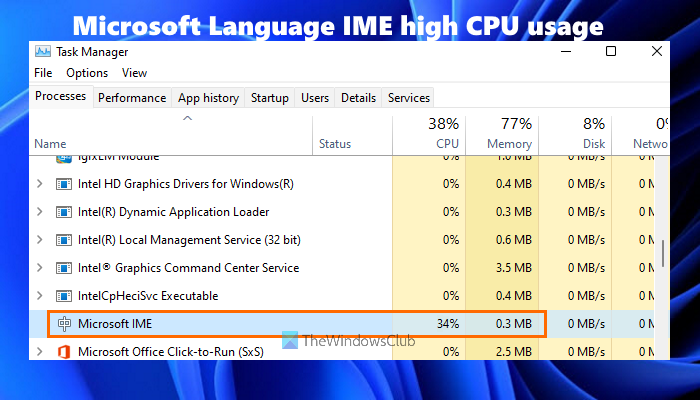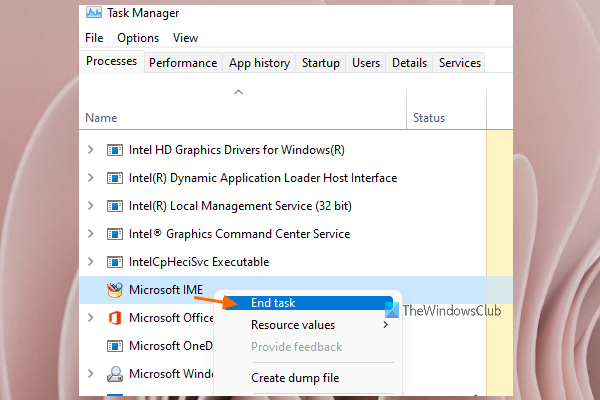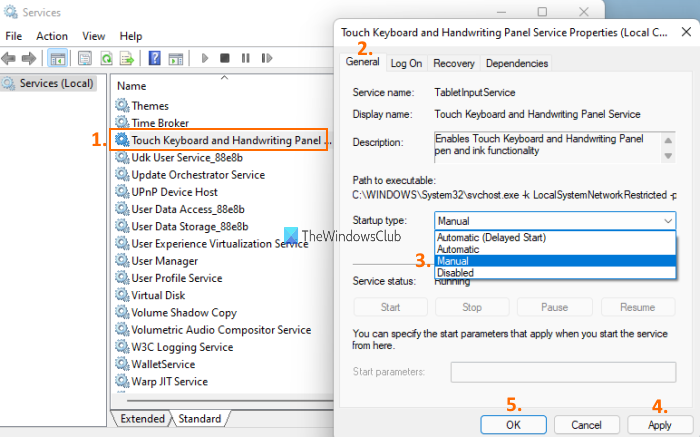If Microsoft Language IME displays high CPU usage in the Task Manager of your Windows 11/10 computer, then this post is sure to help you. Some users have reported that Microsoft IME language when running causes CPU usage of around 30% or more which in turn makes it difficult for users to use other applications smoothly. If you are having this issue, then the solutions covered in this post might come in handy.

What is Microsoft IME in Task Manager?
Microsoft IME is an Input Method Editor that helps the users to input the text in a language that otherwise can’t be represented easily on a standard QWERTY keyboard. Microsoft IME works on physical or hardware keyboards as well as on-screen keyboards. Chinese IME and Japanese IME languages used for entering Chinese characters and Japanese characters are an example of Microsoft IME language.
If you have installed Chinese IME or some other language Microsoft IME, you can change your keyboard layout to that particular language and then type in that specific Microsoft IME language. When some Microsoft IME is running on your Windows 11/10 computer, you can see it in the Processes tab of Task Manager. In some cases, if you are using some Microsoft IME language (mostly Chinese IME language), this may result in high CPU usage that can be seen in Task Manager’s Processes tab. If you face such a problem, then you can try the solutions mentioned below to use Microsoft IME properly.
Fix Microsoft Language IME high CPU usage
Here is a list of solutions that might help you fix the Microsoft language IME high CPU usage problem:
- End Microsoft IME process using Task Manager
- Set Startup Type for Touch Keyboard and Handwriting Panel Service to Manual
- Uninstall KB4516058 Windows Update
- Restore the original ownership of ChsIME.exe.
Let’s have a look at these solutions.
1] End Microsoft IME process using Task Manager

Try this basic solution and see if Microsoft language IME works again normally. Here are the steps:
- Open Task Manager of your Windows 11/10 computer
- Access the Processes tab
- Scroll down to find the Microsoft IME process
- Right-click on the Microsoft IME process
- Select the End task option.
2] Set Startup Type for Touch Keyboard and Handwriting Panel Service to Manual

This solution has worked for many users. The steps to use solution are as follows:
- Click on the Search box of your Windows 11/10 computer
- Type services in the Search box
- Press the Enter key to open the Services window
- Scroll down the page
- Double-click on Touch Keyboard and Handwriting Panel Service
- In the General tab, click on the drop-down menu available for the Startup type section
- In that menu, select the Manual option
- Press the Apply button
- Press the OK button.
Now check if your Microsoft IME language is running fine and CPU usage is OK.
3] Uninstall KB4516058 Windows Update
Many users reported that after they installed KB4516058 Windows Update which was for Chinese IME, then the high CPU problem started. So, if this is the case, you can simply uninstall KB4516058 Windows Update. Windows 11/10 OS provides a built-in option to uninstall Windows updates, including KB4516058 Windows Update. You can access the Installed Updates window and then remove that update.
4] Restore the original ownership of ChsIME.exe
If the high CPU usage happened because of Chinese Simplified Microsoft IME (ChsIME.exe), then there are chances that its original ownership has been changed. So, in that case, you need to restore the original ownership of ChsIME.exe. To do that, follow these steps:
- Open the Task Manager of your Windows 11/10 computer
- Go to the Processes tab
- Scroll down to find the Microsoft IME process
- Right-click on the Microsoft IME process
- Click on the Open file location option. A folder will open where that particular Microsoft IME file will already be selected
- Right-click on that Microsoft IME (in this case ChsIME.exe) file
- Click on the Properties option. A Properties box for that Microsoft IME will open
- Go to the Security tab
- Hit the Advanced button available for special permissions or advanced settings. An Advanced Security Settings window will open for that particular Microsoft IME file
- Click on the Change button available for the Owner section in that window
- A Select User or Group box will open. In that box, type Administrators in the Enter the object name to select the text field
- Press the OK button
- You will come back to the Advanced Security Settings window. Press the OK button to close that window
- Now you will come back to the Properties box of that Microsoft IME file. Go to the Security tab
- Select the SYSTEM option available in Group or user names section
- Click on the Edit… button available for the To change permissions field
- A Permissions box will pop up. In that box, select SYSTEM available in Group or user names section
- Now under the Permissions for SYSTEM section, select the check box for the Read or execute row available for the Deny column
- Press the OK button to close the Permissions box
- You will come back to the Properties box of that Microsoft IME file. There, click on the Advanced button available for special permissions or advanced settings that you did in step 9
- Hit the Change button available for the Owner section in that window just like you did in step 10
- Select User or Group box will open. This time, type NT SERVICE\TrustedInstaller in that box under the Enter the object name to select the text field
- Click on the OK button. This will restore the original ownership of CHsIME.exe
- You will get back to the Advanced Security Settings window. Click on the OK button in that window to close it
- After pressing the OK button, you will return to the Properties box. Again, press the OK button in that box
- Finally, restart your computer.
That’s all! This should solve your problem.
Read next: Input Method Editor (IME) is disabled in Windows 11/10.
How do I get rid of Microsoft IME?
If you want to remove Microsoft IME from your Windows 11/10 computer for a particular language, then you can do that using the Settings app. You need to access where all languages are installed by you. After that, access the Language Options of that Microsoft IME language. There you will see Microsoft IME under the Keyboards section. This is where you will be able to remove that particular Microsoft IME for that language.
Leave a Reply